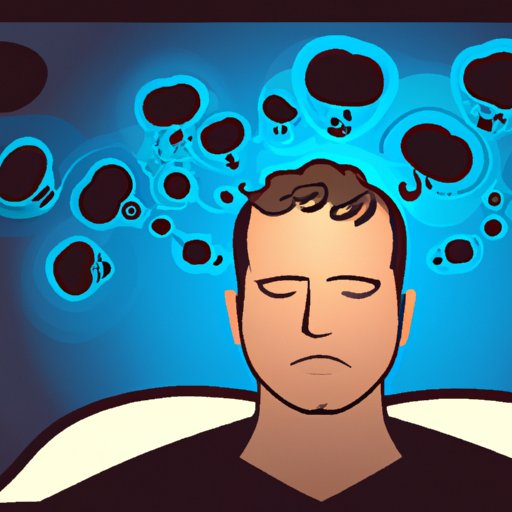Introduction
Dreams are an intriguing phenomenon that has puzzled people for centuries. In general, dreaming is defined as a series of images, emotions, and sensations that occur in the mind during sleep. While we may not be able to make sense of our dreams, there is actually a science behind them. This article will explore how dreams work, from the science and physiology behind them to the different types of dreams, common symbols, and effects of stress on dream content.
Examining the Science Behind Dreams
Dreams are generated by a complex interaction between the brain and body. To better understand this process, it is important to understand the neurophysiology of dreaming. During sleep, the brain undergoes several cycles of activity known as rapid eye movement (REM) and non-REM sleep. During REM sleep, the brain is more active than during non-REM sleep and is responsible for dream generation.
So, how exactly are dreams generated? It is believed that the brain uses past experiences and memories to create dreams. Dreams may also be influenced by external stimuli such as sound, light, and temperature. Additionally, dreams can reflect current emotions and concerns. For example, if you are feeling stressed or anxious, you may have a dream that reflects these feelings.

Exploring Different Types of Dreams
There are many different types of dreams, each with its own set of characteristics. The most common types of dreams include nightmares, recurring dreams, and daydreams.
Nightmares are intense and often frightening dreams that can cause feelings of anxiety, fear, and distress. Nightmares can be caused by stress, traumatic events, and health issues.
Recurring dreams are dreams that occur multiple times, often over a period of months or years. These dreams may contain similar themes or storylines, but the details may change each time. Recurring dreams may indicate unresolved issues or conflicts that need to be addressed.
Daydreams are vivid mental images or fantasies that occur while you are awake. Unlike nightmares, daydreams are usually pleasant and can provide a sense of escapism and relaxation.
The Cognitive Aspects of Dreaming
Dreams can also be beneficial from a cognitive perspective. Research suggests that dreams can play a role in memory consolidation, problem solving, and self-reflection. Memory consolidation occurs when the brain processes and stores information from the day. This helps to ensure that information is retained and can be recalled later.
Dreams can also help with problem solving. When faced with a difficult situation, the brain can use dreams to brainstorm solutions and come up with creative ideas. Finally, dreams can provide insight into one’s thoughts and feelings. By reflecting on dreams, you can gain a better understanding of yourself and your motivations.
Analyzing Common Dream Symbols
Many dreams contain symbols or metaphors that can be interpreted. Common symbols include animals, colors, and objects. Each symbol can have a different meaning depending on the context of the dream. For example, a snake may represent danger or transformation, while a rainbow could symbolize hope or renewal.
It is important to note that cultural influences can also affect the interpretation of symbols. For example, a white horse may symbolize purity in Western culture, while in Eastern cultures it may represent strength and power. Therefore, it is important to take cultural differences into account when interpreting dream symbols.

Investigating How Sleep Affects Dreams
Sleep plays an important role in determining the type and quality of dreams. During sleep, the brain goes through several stages. The first stage is non-REM sleep, which is characterized by slow, regular breathing and low brain activity. During this stage, dreams are less vivid and often forgotten upon waking.
The second stage is REM sleep, which is characterized by rapid eye movements and increased brain activity. During this stage, dreams are more vivid and can be remembered more easily upon waking. Research suggests that REM sleep is essential for normal dream generation.
Understanding Lucid Dreaming
Lucid dreaming is a state of consciousness in which the dreamer is aware that they are dreaming. In a lucid dream, the dreamer can control their actions and environment. Lucid dreaming can be beneficial for those who want to explore their subconscious or practice a skill without the risk of real-world consequences.
However, lucid dreaming can also be dangerous if not practiced properly. It is important to remember that lucid dreams are still dreams and should not be mistaken for reality. Therefore, it is important to approach lucid dreaming with caution.

Investigating the Effects of Stress on Dreams
Stress can have a significant impact on dreams. Research suggests that stressful events can lead to an increase in nightmares and other unpleasant dreams. Additionally, age and gender can affect the content of dreams. For example, adults tend to have more frequent nightmares than children, while women are more likely to experience nightmares than men.
Stressful events can also influence dream content. Studies have found that dreams following a traumatic event often contain themes related to the event. For example, after a car accident, a person may have a dream about driving or being in a car.
Conclusion
Dreams are a fascinating phenomenon that can provide insight into our minds and emotions. The science behind dreams is complex, but research suggests that dreams are generated by a combination of past experiences, memories, and external stimuli. Additionally, there are many different types of dreams, each with its own set of characteristics. Dreams can also be beneficial from a cognitive perspective, as they can help with memory consolidation, problem solving, and self-reflection. Finally, stress can have a significant impact on dreams, leading to an increase in nightmares and other unpleasant dreams.
By exploring the science, types, and effects of dreams, we can gain a better understanding of this mysterious phenomenon.
(Note: Is this article not meeting your expectations? Do you have knowledge or insights to share? Unlock new opportunities and expand your reach by joining our authors team. Click Registration to join us and share your expertise with our readers.)
